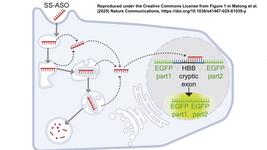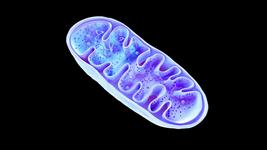CMN Weekly (10 June 2022) - Your Weekly CRISPR Medicine News
By: Gorm Palmgren - Jun. 10, 2022
Top picks
- A new CRISPR-based map ties almost every human gene to its function in the cell. Jonathan Weissman at MIT's Whitehead Institute for Biomedical Research performed genome-scale Perturb-seq targeting all expressed genes with CRISPR interference (CRISPRi) across >2.5 million human cells. In addition to assigning gene function, single-cell transcriptional phenotypes allow for in-depth dissection of complex cellular phenomena - from RNA processing to differentiation.
- German researchers have established a "spacer-nick" gene correction approach that combines the Cas9D10A nickase with a pair of PAM-out sgRNAs at a distance of 200 to 350 bp. The system led to efficient HDR in HSPCs and T cells, with minimal NHEJ-mediated on-target mutations. In addition, the spacer-nick system could correct disease-causing mutations in the HBB, ELANE, IL7R, and PRF1 genes with 20 to 50% efficiencies.
Research
- Chinese researchers have elucidated the molecular mechanism by which a D1135E variant of SpCas9 exhibits much-reduced editing activity at the noncanonical NAG/NGA PAM sites while preserving robust on-target activity at the canonical NGG-flanking sites. It turns out that the noncanonical NAG PAM is engaged with the two PAM-interacting arginine residues in WT SpCas9 via two to three hydrogen bonds. In contrast, the D1135E variant prefers to establish two hydrogen bonds with the PAM bases, accounting for its minimal editing activity on the off-target sites with an NAG PAM. The authors anticipate that the mechanistic knowledge could be leveraged for continuous optimisation of SpCas9 PAM recognition specificity toward high-precision demanding applications.
- Humans have pre-existing adaptive immunity to the RNA-editing enzyme Cas13d from Ruminococcus flavefaciens (RfxCas13d), which should be considered in the development of Cas13d-based therapies. Researchers in Singapore found Cas13d-reactive antibodies and CD4 and CD8 T cell responses in most donors comparable to responses against Cas9 proteins from Staphylococcus aureus (SaCas9) and Streptococcus pyogenes (SpCas9).
- Researchers in China have developed novel chitosan-based nanoparticles for cancer therapy. The nanoparticles can co-deliver the chemotherapeutic doxorubicin and CRISPR-Cas9 plasmids targeting knockout of the oncogene survivin that inhibits apoptosis. Nanoparticles loaded with doxorubicin and CRISPR-Cas9 showed efficient antitumour activity in in vitro and in vivo experiments in mice. Moreover, the efficiency was substantially better than nanoparticles loaded with only one of the agents.
- Chinese scientists have elucidated the cause of off-target effects of CRISPR-Cas12a. They show that the nuclease can still recognise and cleave the target dsDNA sequence even with insertions (DNA bubble) or deletions (RNA bubble). Moreover, the tolerance to these bubbles is closely related to the location and size of the bubble and the GC base content of crRNA.
- CRISPRedict is a new web tool for interpretable gRNA efficiency prediction model for CRISPR-Cas9 gene editing. Researchers in Greece developed the tool, and it offers (i) quick and accurate predictions across various experimental conditions; (ii) regression and classification models for scoring gRNAs and (iii) multiple visualisations to explain the obtained results.
- Iranian researchers describe the development of polyethyleneimine coated-bovine serum albumin nanoparticles (BSA-PEI NPs) to deliver CRISPR-Cas9 systems efficiently. As a result, Cas9/sgRNA RNP complexes could be delivered with up to 92.6% efficiency into breast cancer cells without any remarkable toxicity effects.
- A new attention-based deep learning framework, Apindel, can predict CRISPR-Cas9 repair outcomes. Apindel performs better and delivers more detailed prediction categories than the most advanced DNA-mutation-predicting models. In addition, the model reveals that nucleotides at different positions relative to the cleavage sites have different influences on CRISPR-Cas9 editing outcomes.
Industry
- Allogene Therapeutics has been granted Regenerative Medicine Advanced Therapy (RMAT) designation to ALLO-501A in relapsed/refractory large B cell lymphoma. ALLO-501A is an allogenic anti-CD19 CAR T cell therapy where TALEN gene editing has been used to disrupt the T-cell receptor alpha constant gene (TRAC) and the CD52 gene to reduce the risk of graft-versus-host disease.
- Precision BioSciences has presented promising clinical data for PBCAR019, the company's allogeneic CD19 CAR T cell therapy for aggressive lymphomas. Study subjects achieved a 100% response rate, 73% complete response rate and 50% durable response rate greater than six months. PBCAR0191 is an allogeneic 'off-the-shelf' CAR T therapy that utilises the ARCUS genome editing technology.
- Editas Medicine and Immatics - a clinical-stage biopharmaceutical company active in discovering and developing T cell-redirecting cancer immunotherapies - have entered a strategic research collaboration. The goal is to create gamma-delta T cells with enhanced tumour recognition and destruction.
- Tessera Therapeutics announced that Michael Severino, M.D., has joined the Tessera as Chief Executive Officer. Michael Severino was previously Vice Chairman and President of AbbVie and will now lead Tessera's GENE WRITING technology into the clinic.
- Seelos Therapeutics has announced promising data from an in vitro study of SLS-004, its gene therapy program utilising CRISPR-dCas9 in dementia with Lewy bodies (DLB). The data demonstrated a statistically significant (p<0.01) 19% downregulation of mRNA and a ~40% reduction of alpha-synuclein (SCNA). SLS-004 uses DNA methyltransferase 3A to promote the methylation of SCNA and is also being investigated for treating Parkinson's disease.
Detection
- A simple and fast method for detecting bacterial antimicrobial resistance (AMR) genes is described by researchers in Sweden. Cas9 first recognises the gene of interest and linearises the circular plasmid that harbours the AMR gene. The plasmid is then stretched on a glass surface and visualised by fluorescence microscopy, allowing for detection and detailed information on the number and size of plasmids in the clinical sample.
- Chinese researchers have developed a strategy for rapidly detecting the circulating tumour DNA (ctDNA) BRAF V600E related to aggressive behaviour in papillary thyroid carcinoma. The strategy is based on 3D DNA walker binding to the target ctDNA and subsequent release of large amounts of output DNAs through cyclic cleavage with the assistance of a specific endonuclease. The output DNAs then specifically bind to crRNA and activate the non-specific trans-cleavage activity of Cas12a to generate a fluorescence signal.
- Scientists in China present an ultra-sensitive CRISPR-Cas12a-based assay for detecting DNA methylation. Ultra-low background interference is achieved with a novel methyl-dependent DNA endonuclease GlaI coupled with double cascaded strand displacement amplification. As a result, as low as a 0.1% methylation level can be identified in the presence of excessive unmethylated DNA in down to 38 ng of genomic DNA.
- Researchers in Iran present a highly sensitive fluorescent aptasensor for detecting prostate-specific antigen (PSA) based on integrating a cruciform DNA structure and CRISPR-Cas12a. The aptasensor showed a detection limit of 4 pg/mL and practical use for determining PSA in serum samples.
- Chinese researchers have developed an ultrasensitive sensing platform for microRNA detection using CRISPR-Cas12a and isothermal exponential amplification. The assessment of miR-27a levels in breast cancer cell lines and clinical serum samples was achieved in 60 min with a detection limit down to 90 aM.
- Researchers in China present a method for the rapid and specific diagnosis of the Omicron variant of SARS-CoV-2. The platform is based on CRISPR-Cas12a and surface plasmon resonance, and it can analyse viral RNA without the need for amplification within 38 min and achieve a limit of detection of 15 fM.
Reviews
- A review by researchers in Finland discusses how the integration of CRISPR-Cas systems with programmable DNA nanostructures can be used to improve delivery, targeting and complex dynamic functions. The recent advances are described, and several directions to be further explored are suggested.
Regulation and opinion
- An editorial in Nature Biotechnology looks at the growing interest in genome-editing tools that can insert large chunks of DNA into the genome - and avoid the double-strand breaks associated with CRISPR–Cas9 genotoxicity. The possibilities of base and prime editing are discussed, and other Cas engineered systems like recombinase/integrase and transposase systems are considered.
News from CRISPR Medicine News
- On Wednesday, we looked at what's going on in the CRISPR Medicine field for Leber congenital amaurosis, an inherited group of rare retinal diseases that are the leading cause of childhood blindness.
- Monday was a national holiday, Whit Monday, in Denmark, where CRISPR Medicine News is headquartered, so we did not publish our usual weekly interview.
To get more of the CRISPR Medicine News delivered to your inbox, sign up to the free weekly CMN Newsletter here.
Tags
CLINICAL TRIALS
IND Enabling
Phase I
Phase II
Phase III
Recurrent or Progressive High-grade Glioma, (NCT06737146)
Sponsors:
Suzhou Maximum Bio-tech Co., Ltd.
Sponsors:
Suzhou Maximum Bio-tech Co., Ltd.
IND Enabling
Phase I
Phase II
Phase III
Advanced Peritoneal Malignancies or Abdominal Metastatic Solid Tumors, (NCT06912152)
Sponsors:
Zhejiang University
Sponsors:
Zhejiang University
IND Enabling
Phase I
Phase II
Phase III







